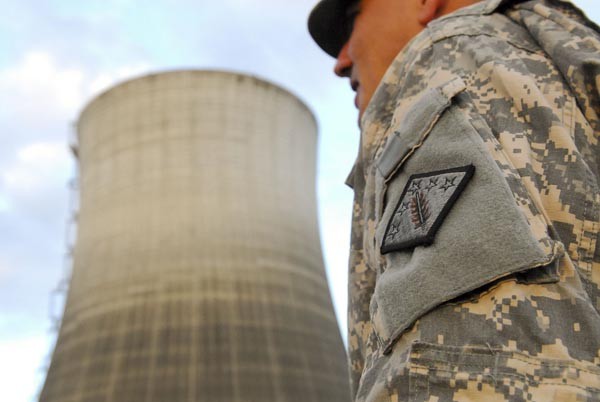SATSOP, Wash. - Under the shadows of the twin nuclear pillars at Satsop, Wash., soldiers with the 31st Chemical Company, 2nd Chemical Biological Radiological Nuclear Battalion, conducted chemical surveillance May 14, as part of an overarching training regimen determined by 2nd CBRN Battalion at Yakima Training Center, Wash.
For a unit stationed in Fort Hood, Texas, training in Washington provided a challenge in addition to a reprieve.
"It's a new place with new terrain," said Sgt. Nathaniel Crudup, biological point detection system operator, 31st Chemical Company, 2nd CBRN Battalion. "The wind shifts a lot and we have to move so we stay downwind of the hazard. I like it [training in Washington]. I think it's a great way to train as opposed to sitting outside the motor pool or sitting in your backyard where you normally do your land navigation."
The training was conducted over several days to ensure a realistic scenario, as well as provide the soldiers as much experience as possible during their tenure here.
"Yesterday, we got our mission brief," Crudup said. "We were told we would be going to set up in an array around the area so we can bio-surveillance the compound in case they release an agent. We came in contact with the agent and our system picked it up. We took a sample and were able to presumably identify what the agent was."
Accuracy is essential when determining a chemical agent and is ensured by due diligence and teamwork.
"You really can't go fast paced here," said Pfc. Samantha Higginbotham, biological point detection system operator, 31st Chemical Company, 2nd CBRN Battalion. "You're constantly communicating with your team and nothing is left out of the loop. Everybody knows what's happening and what's going on next."
The soldiers use a biological point detection system which is essentially a modified high mobility multipurpose wheeled vehicle.
"It's an M998 [humvee] with a shelter top," Crudup said. "It has a 10k generator to power the electronics inside. We have a camera on top that views in infrared in addition to regular views. It [the M998] has a built in collector and identifier that can presumably identify what agents we may come in contact with. It can also take an air sample and turn it into a wet sample which can be split between tech escort and any additional labs they [the U.S. Army] want to send it."
The soldiers of 2nd CBRN Battalion gained experience and built upon confidence they established throughout their training exercises here at Yakima Training Center, Wash.
"I had a lot of confidence in my team before, and I'm even more confident now," Higginbotham said. "I went over with my team leader how to package a sample and we're all on the same page. He had his part down and I had mine. The teamwork and effort that went into the training was exceptional."


Social Sharing